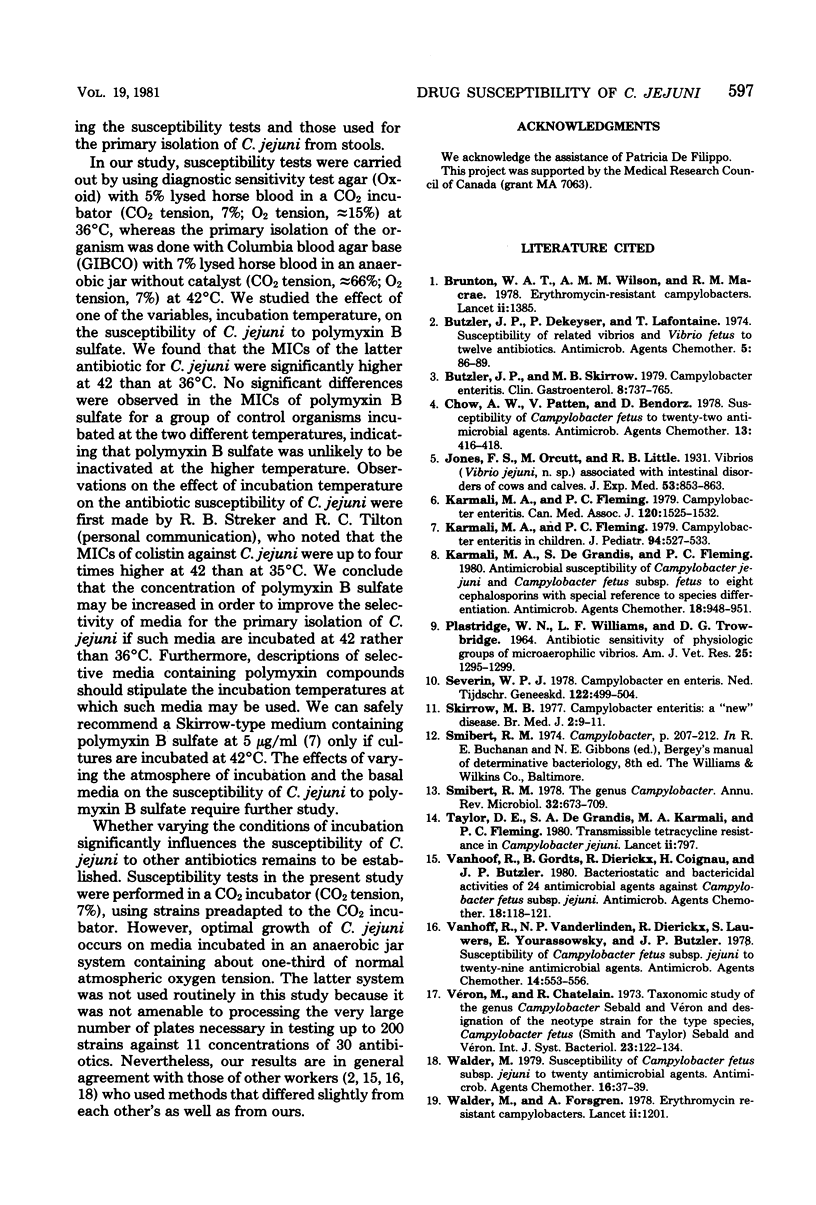Abstract
Agar dilution antimicrobial susceptibility testing of Camphylobacter jejuni showed that erythromycin, clindamycin, nitrofurantoin, and gentamicin were the most active compounds, inhibiting 90% of the isolates at a concentration of 1 microgram/ml or less. The frequency of high-level erythromycin resistance was 1%. Erythromycin-resistant isolates showed cross-resistance to clindamycin. All strains were inhibited by chloramphenicol at less than or equal to 8 micrograms/ml. About 20% of the isolates were resistant to tetracycline at 4 micrograms/ml. All strains were highly resistant to novobiocin, bacitracin, vancomycin, and trimethoprim and resistant to rifampin. The minimal inhibitory concentrations (MICs) of metronidazole ranged from less than or equal to 0.5 to 128 micrograms/ml. The susceptibility of strains to sulfamethoxazole and polymyxin B sulfate was markedly influenced by inoculum size. The MICs of polymyxin B sulfate were significantly higher at 42 than 36 degrees C. All strains were inhibited by nalidixic acid at 32 micrograms/ml. In the penicillin group, ampicillin was the most active compound, inhibiting only about three-quarters of the strains at 8 micrograms/ml. The cephalosporins as a group showed only moderate to poor activity, the most active cephalosporin being cefotaxime, which inhibited about 90% of the strains at 8 micrograms/ml. The use of antibiotics in selective media is discussed.
Full text
PDF




Selected References
These references are in PubMed. This may not be the complete list of references from this article.
- Brunton W. A., Wilson A. M., Macrae R. M. Erythromycin-resistant campylobacters. Lancet. 1978 Dec 23;2(8104-5):1385–1385. doi: 10.1016/s0140-6736(78)92027-5. [DOI] [PubMed] [Google Scholar]
- Butzler J. P., Dekeyser P., Lafontaine T. Susceptibility of related vibrios and Vibrio fetus to twelve antibiotics. Antimicrob Agents Chemother. 1974 Jan;5(1):86–89. doi: 10.1128/aac.5.1.86. [DOI] [PMC free article] [PubMed] [Google Scholar]
- Butzler J. P., Skirrow M. B. Campylobacter enteritis. Clin Gastroenterol. 1979 Sep;8(3):737–765. [PubMed] [Google Scholar]
- Chow A. W., Patten V., Bednorz D. Susceptibility of Campylobacter fetus to twenty-two antimicrobial agents. Antimicrob Agents Chemother. 1978 Mar;13(3):416–418. doi: 10.1128/aac.13.3.416. [DOI] [PMC free article] [PubMed] [Google Scholar]
- Karmali M. A., De Grandis S., Fleming P. C. Antimicrobial susceptibility of Campylobacter jejuni and Campylobacter fetus subsp. fetus to eight cephalosporins with special reference to species differentiation. Antimicrob Agents Chemother. 1980 Dec;18(6):948–951. doi: 10.1128/aac.18.6.948. [DOI] [PMC free article] [PubMed] [Google Scholar]
- Karmali M. A., Fleming P. C. Campylobacter enteritis in children. J Pediatr. 1979 Apr;94(4):527–533. doi: 10.1016/s0022-3476(79)80004-9. [DOI] [PubMed] [Google Scholar]
- Karmali M. A., Fleming P. C. Campylobacter enteritis. Can Med Assoc J. 1979 Jun 23;120(12):1525–1532. [PMC free article] [PubMed] [Google Scholar]
- PLASTRIDGE W. N., WILLIAMS L. F., TROWBRIDGE D. G. ANTIBIOTIC SENSITIVITY OF PHYSIOLOGIC GROUPS OF MICROAEROPHILIC VIBRIOS. Am J Vet Res. 1964 Jul;25:1295–1299. [PubMed] [Google Scholar]
- Severin W. P. Campylobacter en enteritis. Ned Tijdschr Geneeskd. 1978 Apr 15;122(15):499–504. [PubMed] [Google Scholar]
- Skirrow M. B. Campylobacter enteritis: a "new" disease. Br Med J. 1977 Jul 2;2(6078):9–11. doi: 10.1136/bmj.2.6078.9. [DOI] [PMC free article] [PubMed] [Google Scholar]
- Smibert R. M. The genus Campylobacter. Annu Rev Microbiol. 1978;32:673–709. doi: 10.1146/annurev.mi.32.100178.003325. [DOI] [PubMed] [Google Scholar]
- Taylor D. E., DeGrandis S. A., Karmali M. A., Fleming P. C. Transmissible tetracycline resistance in Campylobacter jejuni. Lancet. 1980 Oct 11;2(8198):797–797. doi: 10.1016/s0140-6736(80)90404-3. [DOI] [PubMed] [Google Scholar]
- Vanhoof R., Gordts B., Dierickx R., Coignau H., Butzler J. P. Bacteriostatic and bactericidal activities of 24 antimicrobial agents against Campylobacter fetus subsp. jejuni. Antimicrob Agents Chemother. 1980 Jul;18(1):118–121. doi: 10.1128/aac.18.1.118. [DOI] [PMC free article] [PubMed] [Google Scholar]
- Walder M., Forsgren A. Erythromycin-resistant Campylobacters. Lancet. 1978 Dec 2;2(8101):1201–1201. doi: 10.1016/s0140-6736(78)92182-7. [DOI] [PubMed] [Google Scholar]
- Walder M. Susceptibility of Campylobacter fetus subsp. jejuni to twenty antimicrobiol agents. Antimicrob Agents Chemother. 1979 Jul;16(1):37–39. doi: 10.1128/aac.16.1.37. [DOI] [PMC free article] [PubMed] [Google Scholar]


